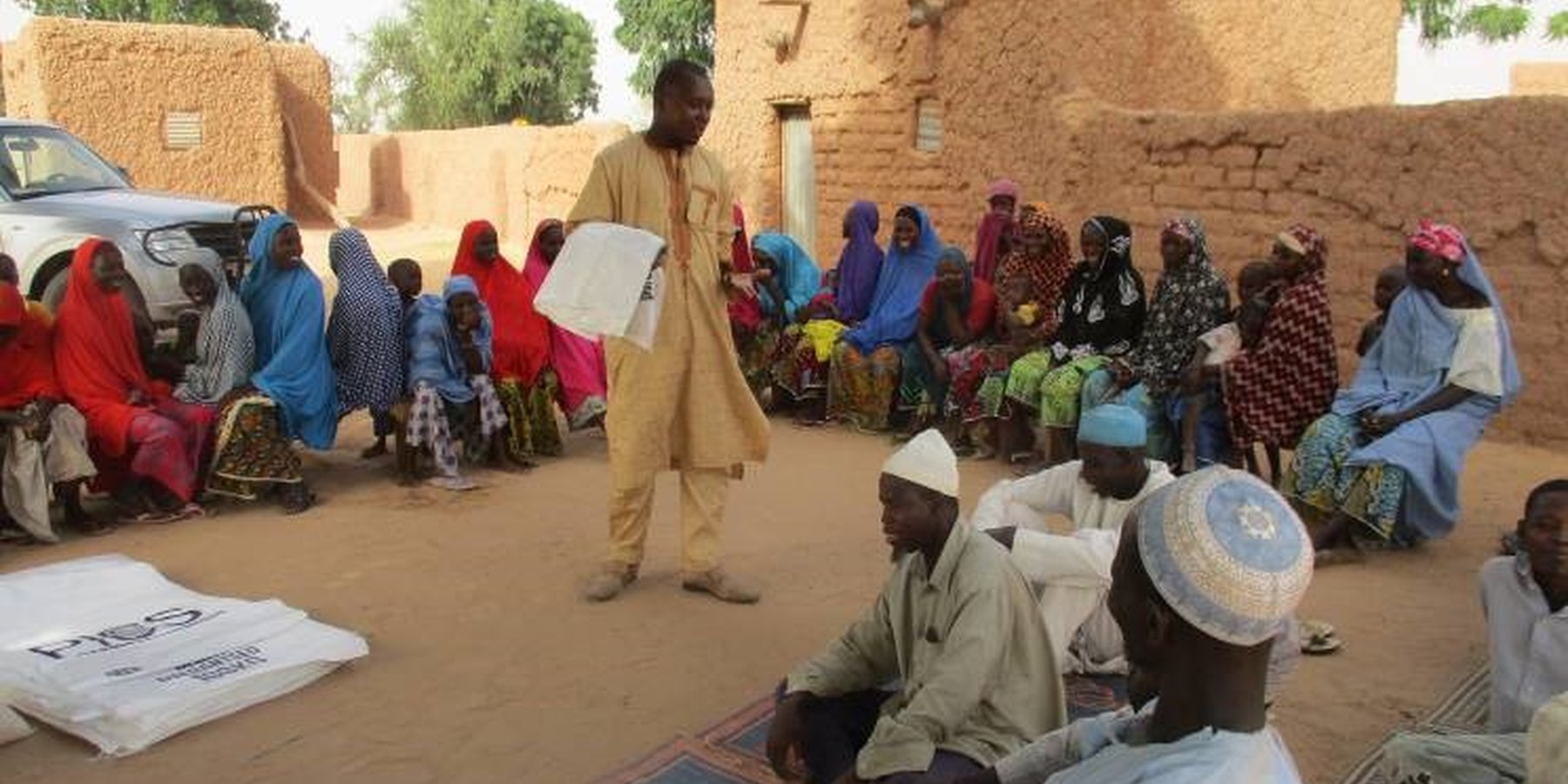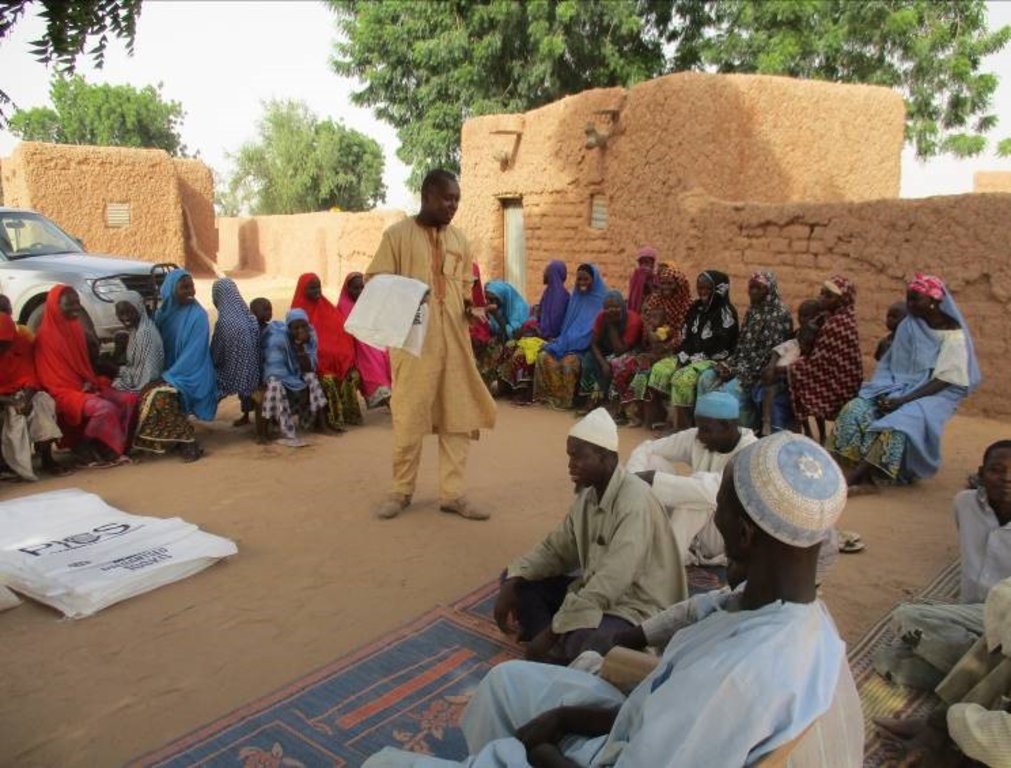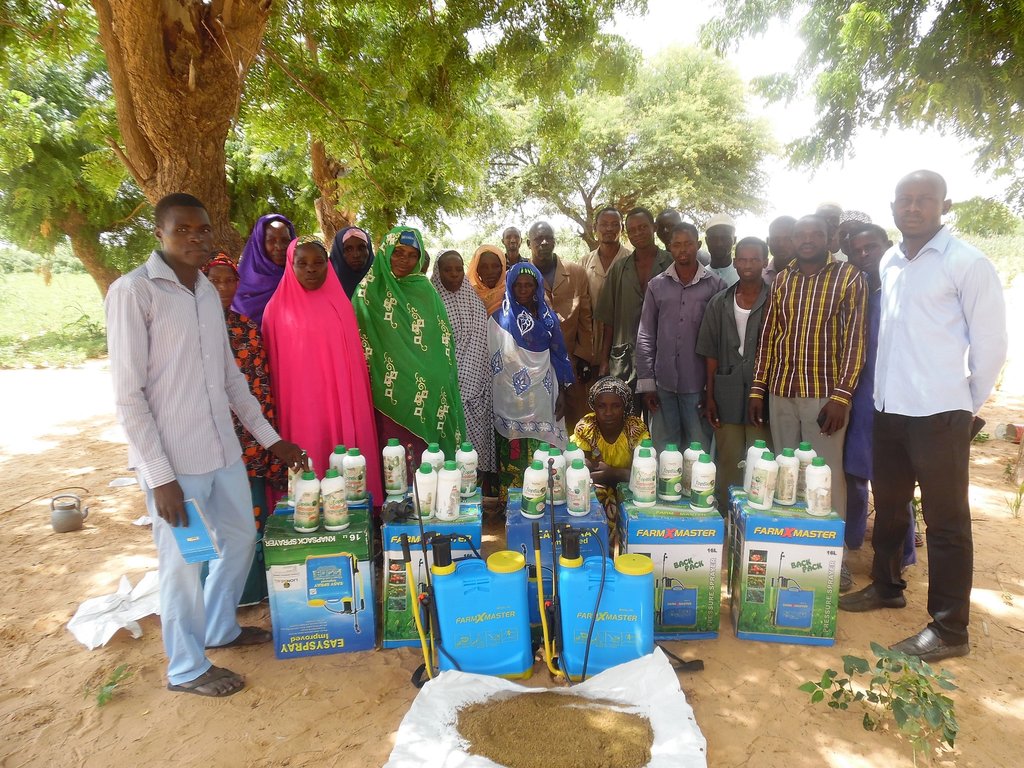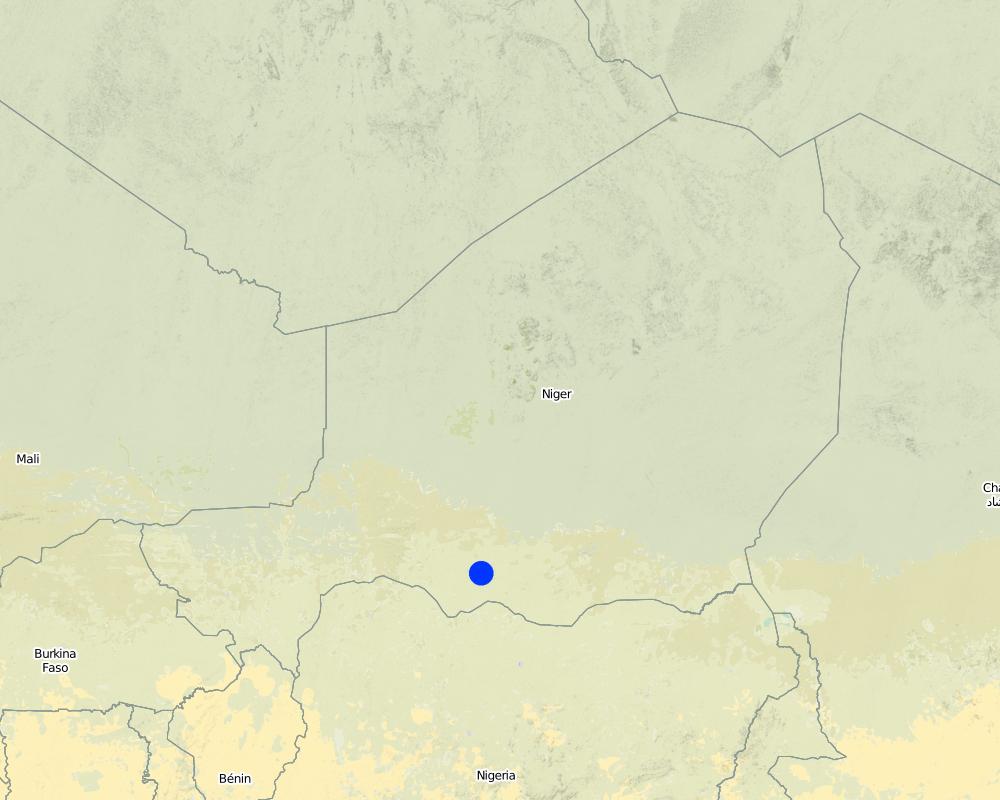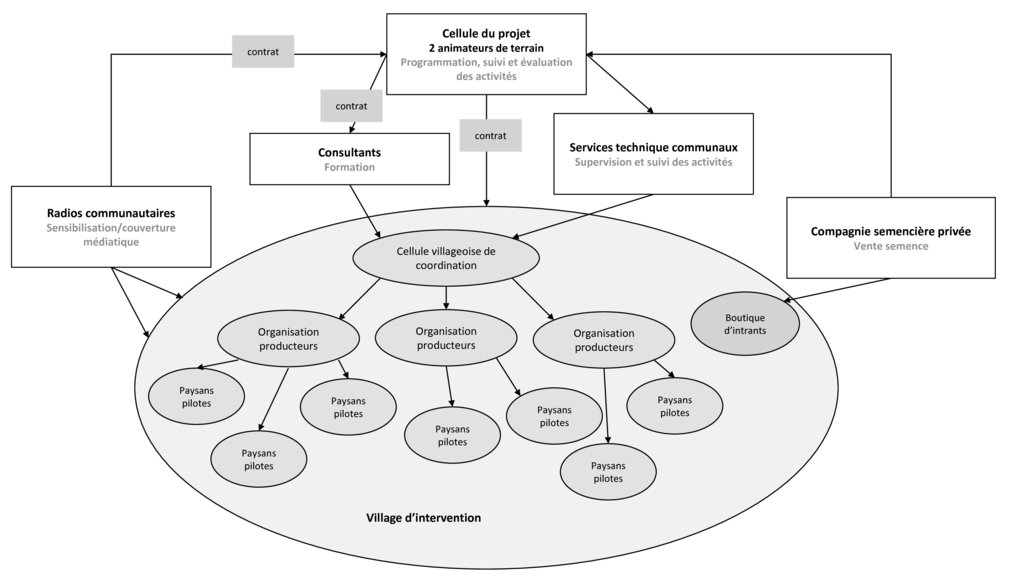Training and awareness raising in the use of improved agricultural techniques [Niger]
- Creation:
- Update:
- Compiler: Judith Macchi
- Editors: Christine Lottje, Rabé Mahamane Moctar
- Reviewers: David Beritault, Alexandra Gavilano
Horon karama jouna sani daziyara dakouma sallar kofofi budé
approaches_680 - Niger
View sections
Expand all Collapse all1. General information
1.2 Contact details of resource persons and institutions involved in the assessment and documentation of the Approach
Key resource person(s)
SLM specialist:
Baoua Ibrahim
96970190 / 90423573
baoua.ibrahim@gmail.com
University of Maradi
baoua.ibrahim@gmail.com
Niger
Name of project which facilitated the documentation/ evaluation of the Approach (if relevant)
Book project: where people and their land are safer - A Compendium of Good Practices in Disaster Risk Reduction (DRR) (where people and their land are safer)Name of the institution(s) which facilitated the documentation/ evaluation of the Approach (if relevant)
HEKS (Hilfswerk der Evangelischen Kirchen Schweiz) (HEKS (Hilfswerk der Evangelischen Kirchen Schweiz)) - Switzerland1.3 Conditions regarding the use of data documented through WOCAT
When were the data compiled (in the field)?
12/10/2016
The compiler and key resource person(s) accept the conditions regarding the use of data documented through WOCAT:
Yes
1.4 Reference(s) to Questionnaire(s) on SLM Technologies
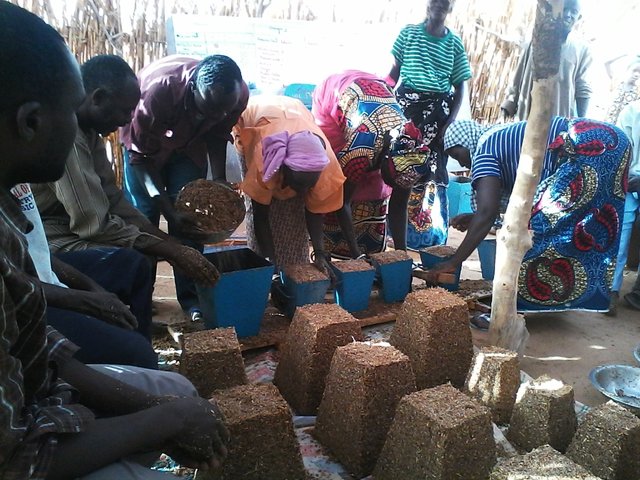
Multi-Nutritional Fodder Blocks for livestock [Niger]
Multi-Nutritional Blocks for livestock are an alternative animal feed for all seasons. They are a concentrate of nutritious elements prepared from crop residues such as stalks, pods, etc.
- Compiler: Judith Macchi
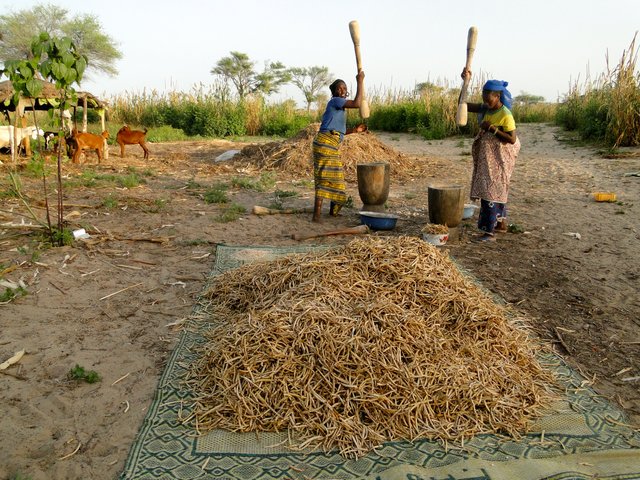
Improved cowpea variety (IT90k372-1-2) [Niger]
The improved cowpea variety (IT90k372-1-2) has a short cycle, multiple resistance and is adapted to the tropical agro-ecological zone.
- Compiler: Judith Macchi
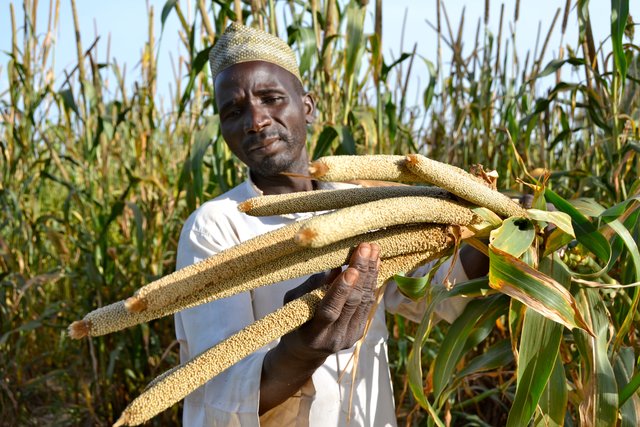
Improved millet variety HKP [Niger]
The millet variety HKP, "Haini Kire Précoce" in Djerma language (finger millet in English), is a high-yielding millet variety, adapted to the Sahelian context
- Compiler: Judith Macchi
2. Description of the SLM Approach
2.1 Short description of the Approach
This approach consists of disseminating improved agricultural techniques to increase the agricultural production. Producers are trained to demonstrate the techniques, and demonstration events are organised to make other producers aware of the use of these improved techniques.
2.2 Detailed description of the Approach
Detailed description of the Approach:
This is a project to train producers and to make them aware of agro-ecological intensification, and to implement demonstration plots with the following agricultural techniques:
- improved land clearing;
- the use of improved varieties of millet and cowpea;
- techniques of mono-cropping or strip cropping;
- integrated water management and soil fertility management with the Zaï technique (cultivation in pockets) with localized input of organic manure;
- the management of insect pests with biological control and the use of bio-pesticide made from Neem seed;
- post-harvest protection techniques without pesticides.
These existing techniques are implemented to contribute to the food security with yield increases of at least 50%. Animal feeding has been intensified by the establishment of 3 community production units and the selling of multi-nutritional fodder blocks. The approach used is participatory, because it initially consists of identifying the needs of the producers. It enables the involvement of all stakeholders (researchers-extension workers-producers), and then strengthening of the relations between them as well as their capacities through exchanges and training. This approach is also combined with Open Days, which are organised at regular intervals to present new and relevant technologies. The producers appreciate to be involved in solving their typical problems.
The implementation of the project has started with a kick-off meeting with the entire project team, the farmer organisations at the village level, the community leaders and the technical services. All the activities of the project were presented and propositions were made for the responsibilities of each of the partners:
- The team takes charge of the programming, the monitoring and the evaluation of the activities at the level of each of the villages. Each extension worker is charged with managing the activities at the level of 20 villages.
- The technical service for agriculture takes charge of supervising the agricultural activities, is involved in the selection of the producers, the technical training, and in the assistance and advice to producers in the application of the technologies and the assessment of the yields.
- The technical service for livestock farming has taken charge of technical advice and of the monitoring of the private production units of the Multi-Nutritional Fodder Blocks for livestock. It is involved in the awareness raising of the livestock farmers on animal feeding and the use of the fodder blocks.
- The farmer organisations in the villages are involved in the implementation of the activities by the establishment of a management committee.
2.3 Photos of the Approach
2.5 Country/ region/ locations where the Approach has been applied
Country:
Niger
Region/ State/ Province:
Maradi
Further specification of location:
Mayahi
Comments:
longitude: 07.48.639°
Latitude: 13.8511°
Map
×2.6 Dates of initiation and termination of the Approach
Indicate year of initiation:
2014
2.7 Type of Approach
- project/ programme based
2.8 Main aims/ objectives of the Approach
- Increase the utilization rate of improved varieties adapted to the agricultural context of the intervention zone
- Establish demonstration units for promising agricultural technologies to increase the yields of millet and cowpea
- Strengthen the capacity of the producers to use techniques for the recovery of agricultural by-products in animal feeding
- Involve producers in the decision-making and the solving of problems that concern them.
2.9 Conditions enabling or hindering implementation of the Technology/ Technologies applied under the Approach
social/ cultural/ religious norms and values
- enabling
The producers are open to innovation and are involved in the decision-making which concerns them.
availability/ access to financial resources and services
- hindering
The financial sources are low, which limits the investment potential of the producers.
collaboration/ coordination of actors
- enabling
All stakeholders are involved.
policies
- enabling
The public authorities facilitate the activities.
knowledge about SLM, access to technical support
- enabling
The technical fact sheets helped the producers to understand and implement the technology.
markets (to purchase inputs, sell products) and prices
- enabling
Collective marketing helps producers to obtain a larger farm income.
workload, availability of manpower
- hindering
The workload is high, especially for the Zaï technique.
3. Participation and roles of stakeholders involved
3.1 Stakeholders involved in the Approach and their roles
- local land users/ local communities
Producers (men and women)
Provide land and organic manure
Collection of neem seed required for the local production of bio-pesticide
Labour for farming operations, including soil and water conservation structures
- community-based organizations
Farmer organisations
Provide premises for the production units for the MNDB
Purchase of raw materials
- SLM specialists/ agricultural advisers
Field officers (agronomic engineers)
Training of the producers
- researchers
Researchers from the university of Dan Dicko Dankoulodo of Maradi and the INRAN (National Agronomic Research Institute in Niger)
Training of the field officers
Evaluation of the project activities
- NGO
Sahel Bio: research agency financed by the HEKS to support food security by agro-ecological intensification in the department of Mayahi
Coordination
Financing of seed, small agricultural equipment such as row units, rope, bio-pesticides, parasitoid insects
- local government
Prefect and mayors
Monitoring the project activities
If several stakeholders were involved, indicate lead agency:
The lead agency is the research agency Sahel Bio, coordinated by a teacher-researcher, and assisted by a researcher from the INRAN.
3.2 Involvement of local land users/ local communities in the different phases of the Approach
| Involvement of local land users/ local communities | Specify who was involved and describe activities | |
|---|---|---|
| initiation/ motivation | interactive | The local land users were consulted by the project team in the initiation phase. |
| planning | interactive | A kick-off meeting gathered the entire project team, the farmer organisations at the level of the villages, the community officials and the technical services. The project activities were shared and the responsibilities of each of the partners were made explicit. |
| implementation | interactive | The producers provide the land and the organic manure. They collect the neem seed required for the local production of bio-pesticide, and will be charged with all the labour for the agricultural field operations. |
| monitoring/ evaluation | interactive | The project team, in collaboration with the producers has charged itself with the monitoring of the activities at the level of each of the villages. An external consultant was hired to evaluate the project. |
3.3 Flow chart (if available)
Description:
The project is in charge of the programming, monitoring and evaluation of the activities at the village level. The technical services take care of the supervision and the monitoring of the supported activities. A contract is signed with the consultants for the training of the producers. Another contract is signed with the community radio stations to broadcast the proceedings, allowing to disseminate knowledge on the technologies and their advantages to several villages in the department which are covered by the radio. The coordinating village unit is composed of existing farmer organisations in the villages which are involved in the implementation of the activities by a committee of two persons per village: a man and a women who will be charged with the monitoring of the activities. They will assist the project team in the selection of the producers.
Author:
Baoua Ibrahim, Project coordinator
3.4 Decision-making on the selection of SLM Technology/ Technologies
Specify who decided on the selection of the Technology/ Technologies to be implemented:
- all relevant actors, as part of a participatory approach
Explain:
In a meeting with the entire project team, the farmer organisations at the village level, the community officials and the technical services, all the project activities were discussed and approved.
Specify on what basis decisions were made:
- research findings
4. Technical support, capacity building, and knowledge management
4.1 Capacity building/ training
Was training provided to land users/ other stakeholders?
Yes
Specify who was trained:
- land users
- field staff/ advisers
Form of training:
- farmer-to-farmer
- demonstration areas
- public meetings
Subjects covered:
Training producers on the roadmap of technologies
Training on techniques for water management and soil fertility management
Training on pest management
Training on improved storage of harvests
Comments:
The demonstrations of new technologies involved 400 producers in total, of whom 40% women.
4.2 Advisory service
Do land users have access to an advisory service?
Yes
Specify whether advisory service is provided:
- on land users' fields
- at permanent centres
Describe/ comments:
Advisory service is provided on request of land users, or during the diagnostic survey. The advisory service centers are supervised by the department of agriculture.
4.3 Institution strengthening (organizational development)
Have institutions been established or strengthened through the Approach?
- no
4.4 Monitoring and evaluation
Is monitoring and evaluation part of the Approach?
Yes
If yes, is this documentation intended to be used for monitoring and evaluation?
No
4.5 Research
Was research part of the Approach?
Yes
Specify topics:
- sociology
- technology
Give further details and indicate who did the research:
The project team, consisting of researchers of the university of Maradi and of the National Agronomic Research Institute (INRAN/MARADI), works actively on the impact of the technology on the land users, as well as on the factors determining the adoption of the technology.
5. Financing and external material support
5.1 Annual budget for the SLM component of the Approach
If precise annual budget is not known, indicate range:
- 10,000-100,000
Comments (e.g. main sources of funding/ major donors):
HEKS/EPR
5.2 Financial/ material support provided to land users
Did land users receive financial/ material support for implementing the Technology/ Technologies?
Yes
If yes, specify type(s) of support, conditions, and provider(s):
The project provided the seed of cowpea (IT90k372-1-2) and millet (HKP), small agricultural equipment such as row units, rope, bio-pesticides, parasitoid insects as well as demonstration material.
5.3 Subsidies for specific inputs (including labour)
- equipment
| Specify which inputs were subsidised | To which extent | Specify subsidies |
|---|---|---|
| tools | fully financed | Row units, ropes and ploughs are financed |
- agricultural
| Specify which inputs were subsidised | To which extent | Specify subsidies |
|---|---|---|
| seeds | fully financed | |
If labour by land users was a substantial input, was it:
- voluntary
Comments:
The producers provided the land, organic manure and all the labour for the agricultural field operations. They collected the neem seed required for the local production of bio-pesticide.
5.4 Credit
Was credit provided under the Approach for SLM activities?
No
5.5 Other incentives or instruments
Were other incentives or instruments used to promote implementation of SLM Technologies?
Yes
If yes, specify:
Open days
6. Impact analysis and concluding statements
6.1 Impacts of the Approach
Did the Approach empower local land users, improve stakeholder participation?
- No
- Yes, little
- Yes, moderately
- Yes, greatly
Did the Approach enable evidence-based decision-making?
- No
- Yes, little
- Yes, moderately
- Yes, greatly
The demonstration sites and the open days allowed non-trained producers to see the advantages experienced by trained producers. A study conducted in November 2016 showed that the estimated rate of adoption of the technology varied from 14 to 96% for the trained producers, and from 10 to 88% for the non-trained producers.
Did the Approach help land users to implement and maintain SLM Technologies?
- No
- Yes, little
- Yes, moderately
- Yes, greatly
The consideration of the real needs of producers by involving them in the process has motivated them in the adoption and implementation of the technology.
Did the Approach mobilize/ improve access to financial resources for SLM implementation?
- No
- Yes, little
- Yes, moderately
- Yes, greatly
The approach does not allow access to financial resources.
Did the Approach improve knowledge and capacities of land users to implement SLM?
- No
- Yes, little
- Yes, moderately
- Yes, greatly
The capacities of all the targeted producers have been strengthened, and they have all been able to upscale the technologies.
Did the Approach improve knowledge and capacities of other stakeholders?
- No
- Yes, little
- Yes, moderately
- Yes, greatly
Apart from the targeted producers, the knowledge and capacities of the agricultural advisers were improved.
Did the Approach build/ strengthen institutions, collaboration between stakeholders?
- No
- Yes, little
- Yes, moderately
- Yes, greatly
The collaboration of the project team with the department of agriculture was strengthened.
Did the Approach empower socially and economically disadvantaged groups?
- No
- Yes, little
- Yes, moderately
- Yes, greatly
Did the Approach improve gender equality and empower women and girls?
- No
- Yes, little
- Yes, moderately
- Yes, greatly
Women are involved in the same way as men.
Did the Approach lead to improved food security/ improved nutrition?
- No
- Yes, little
- Yes, moderately
- Yes, greatly
The yields of cowpea have increased up to 50%.
Did the Approach improve the capacity of the land users to adapt to climate changes/ extremes and mitigate climate related disasters?
- No
- Yes, little
- Yes, moderately
- Yes, greatly
The approach helps producers to grow varieties with higher tolerance to long dry periods.
6.2 Main motivation of land users to implement SLM
- increased production
An increase of up to 50%
- increased profit(ability), improved cost-benefit-ratio
Income multiplied by 2
- reduced risk of disasters
Interest in seed resistant to drought
6.3 Sustainability of Approach activities
Can the land users sustain what has been implemented through the Approach (without external support)?
- yes
If yes, describe how:
The producers have already initiated other producers into the use of the technologies. Dissemination is done from producer to producer, and in a participatory way.
6.4 Strengths/ advantages of the Approach
| Strengths/ advantages/ opportunities in the land user’s view |
|---|
| Our involvement in the entire process |
| The demand comes from ourselves |
| Strengths/ advantages/ opportunities in the compiler’s or other key resource person’s view |
|---|
| A better relationship between all stakeholders |
| Strengthening of the capacities of all actors |
| The consideration of the real needs of the producers |
6.5 Weaknesses/ disadvantages of the Approach and ways of overcoming them
| Weaknesses/ disadvantages/ risks in the land user’s view | How can they be overcome? |
|---|---|
| The meetings and the stakeholder engagement require resources | Financial assistance |
| Weaknesses/ disadvantages/ risks in the compiler’s or other key resource person’s view | How can they be overcome? |
|---|---|
| Approach subject to constraints (in terms of human and financial resources) | Mobilization of financial resources |
| Lack of accompanying measures for the demonstrations | Mobilization of financial resources |
| Challenges in terms of organisation (high cost and organisational capacity) | Mobilization of financial resources |
7. References and links
7.1 Methods/ sources of information
- field visits, field surveys
10
- interviews with land users
10
- interviews with SLM specialists/ experts
2
- compilation from reports and other existing documentation
3
7.2 References to available publications
Title, author, year, ISBN:
FIDA (2001) : Vulgarisation agricole et appui à l’innovation paysanne en Afrique de l’ouest et centrale: bilan et perspectives pour le FIDA.
Available from where? Costs?
http://www.agencemicroprojets.org/wp-content/uploads/etudes29257/CFSI_Nourrirlesvilles_BD-31.pdf
7.3 Links to relevant information which is available online
Title/ description:
Documents of the West African Power Pool (WAPP) from Niger, Senegal, Ghana, Mali, Ivory Coast and Nigeria.
URL:
https://www.afdb.org/fileadmin/uploads/afdb/Documents/Policy-Documents/DSIR%20pour%20l'Afrique%20d
Links and modules
Expand all Collapse allLinks

Multi-Nutritional Fodder Blocks for livestock [Niger]
Multi-Nutritional Blocks for livestock are an alternative animal feed for all seasons. They are a concentrate of nutritious elements prepared from crop residues such as stalks, pods, etc.
- Compiler: Judith Macchi

Improved cowpea variety (IT90k372-1-2) [Niger]
The improved cowpea variety (IT90k372-1-2) has a short cycle, multiple resistance and is adapted to the tropical agro-ecological zone.
- Compiler: Judith Macchi

Improved millet variety HKP [Niger]
The millet variety HKP, "Haini Kire Précoce" in Djerma language (finger millet in English), is a high-yielding millet variety, adapted to the Sahelian context
- Compiler: Judith Macchi
Modules
No modules


